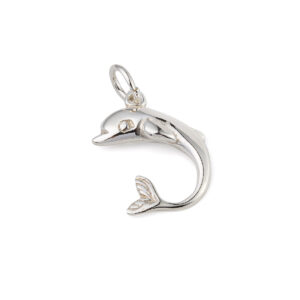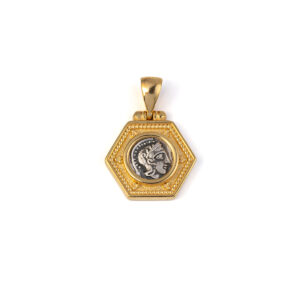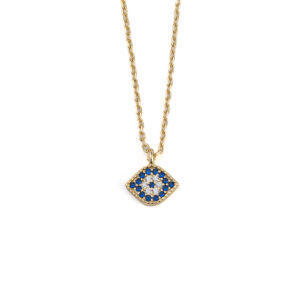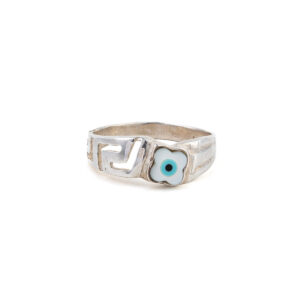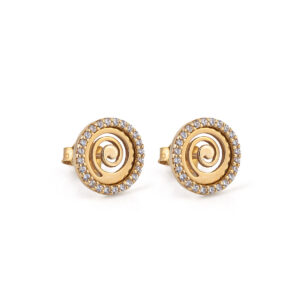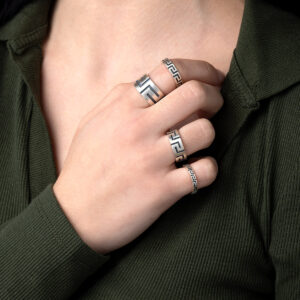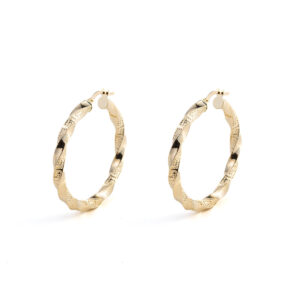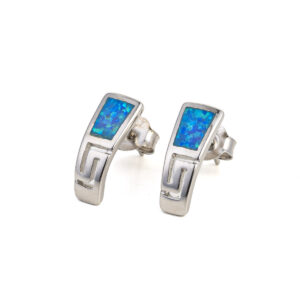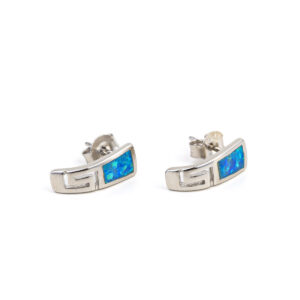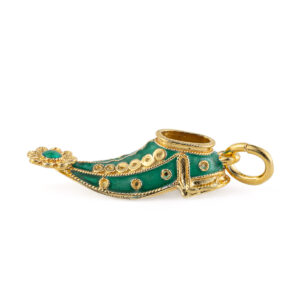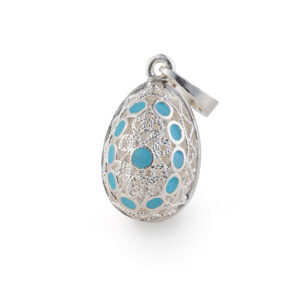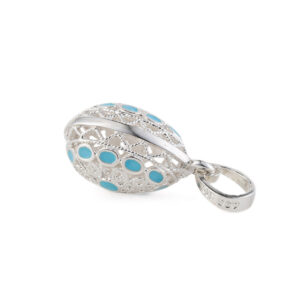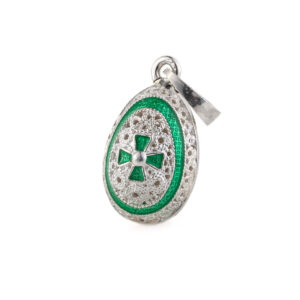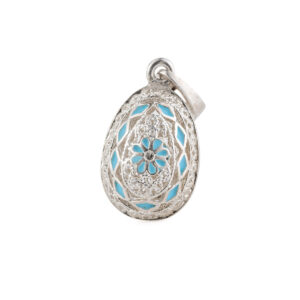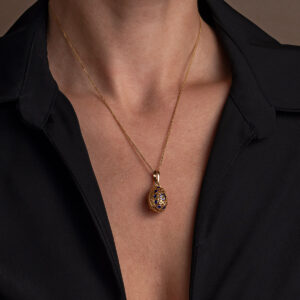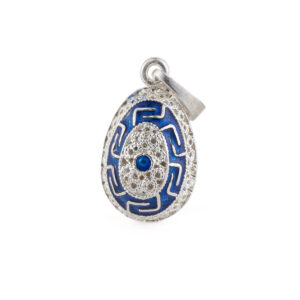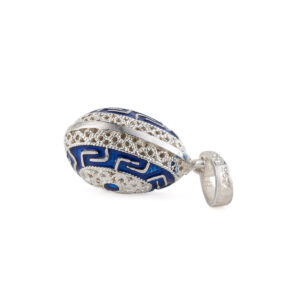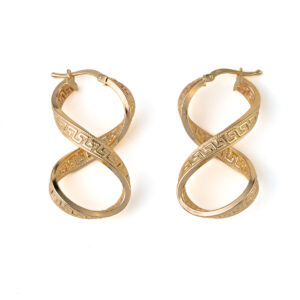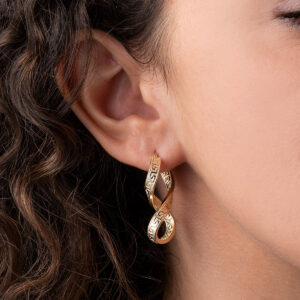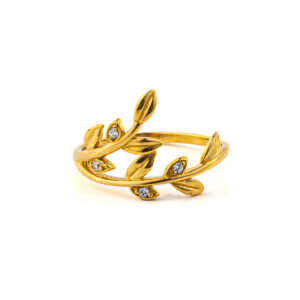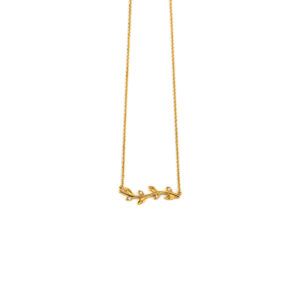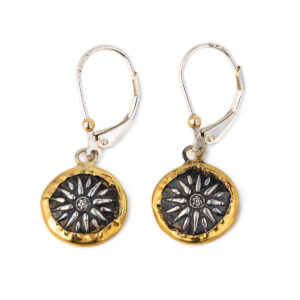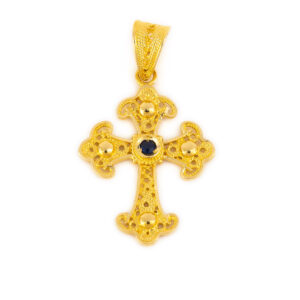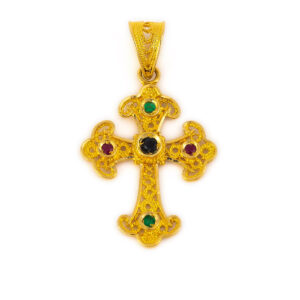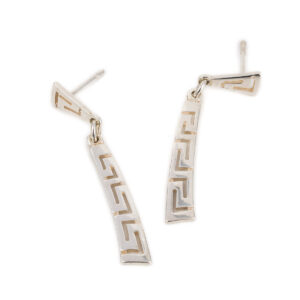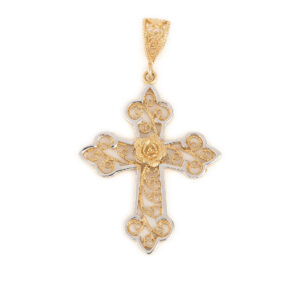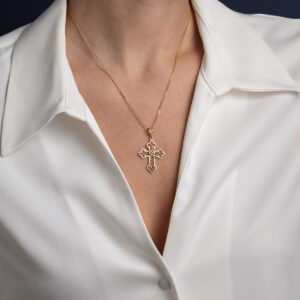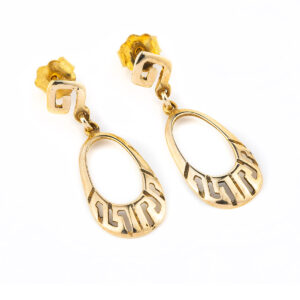Dolphin Pendant – 925 Sterling Silver
Made of 925 sterling silver.
Handmade in Greece.
Explore Heritage Collection
Athena Coin Pentagon Pendant – 14K Gold and Sterling Silver
Pendant inspired by the ancient Greek tetradrachm.
Made of sterling silver 925° and 14k gold.
Handmade in Greece.
The chain shown in the second picture is our Cable Chain – 925 Sterling Silver and Gold Plated (included).
Explore Coins Collection
Goddess Athena and Owl – Athenian silver tetradrachm
Dracma was the currency used in Greece during several periods in its history. The tetradrachm was an Ancient Greek silver coin equivalent to fourdrachmae in Athens it replaced the earlier “heraldic” type of didrachms and it was in wide circulation from ca. 510 to ca. 38 BC. This coin belongs to the so-called “new style Athenian coins” minted between 166 and 64 B.C. and is considered one of the most popular ancient Greek coins which illustrate the portrait of Goddess Athena on the one side and the wisdom owl on the other. Athena is an ancient Greek goddess associated with wisdom, handicraft, and warfare. Athena was regarded as the patron and protectress of various cities across Greece, particularly the city of Athens, from which she most likely received her name. She’s usually shown in art wearing a helmet and holding a spear. Her major symbols include owls, olive trees, and snakes. Her temples were located atop the fortified Acropolis in the central part of the city. The Parthenon on the Athenian Acropolis is dedicated to her, along with numerous other temples and monuments. Her main festival in Athens was the Panathenaia, which was celebrated in midsummer and was the most important festival on the Athenian calendar.
Evil Eye Zircon Necklace – 925 Sterling Silver and Gold Plated
Made of sterling silver 925° and gold plated.
Handmade in Greece.
Explore Mati Collection
Evil Eye
The symbol and superstition of the evil eye is one of the strongest symbolic images in the world. The earliest known evidence for belief in the evil eye goes back to ancient Greece and Rome. It is supposed to wear off evil to anyone who wears it and various cultures believe in that, however in Greece, it’s blue because at that time blue eyes were not so common and were thought to give the evil eye, so the blue is like a mirror to them. Nowadays it’s widely known and has become a trend.
Meander Flower Ring – 925 Sterling Silver
Ring inspired by the Greek Key meander symbol.
Made of sterling silver 925°.
Handmade in Greece.
Explore Meandros Collection
History
Meandros design is a decorative border constructed from a continuous line, shaped into a repeated motif. Such a design is also called the Greek fret or Greek key design, although these are modern designations. On the one hand, the name “meander” recalls the twisting and turning path of the Meander River in Asia Minor, and on the other hand, as Karl Kerenyi pointed out, “the meander is the figure of a labyrinth in linear form” the meaning is that there is no beginning and no end in some cases so it becomes the symbol of long life and eternity.
Spiral Stud Earrings – 14K Solid Yellow Gold
492,00€Made of 14k gold with zircon.
Handmade in Greece.
Explore Spiral Collection
The spiral is one of the oldest symbols of human spirituality, carved or painted into rocks from thousands of years ago. Symbol of movement and progressive development, growth, expansion, cosmic energy, symbol of the sun. Spirals have been found in burial sites, in vases, in jewelry, clothing, weapons… They can be seen in every aspect of nature, like the tides in the oceans, the winds, the plants, the shells. The spiral phenomenon has been explained through mathematics from the time of Archimedes, the great Greek mathematician.
Sterling Silver Marquise Drop Pendant Necklace
A beautiful necklace representing the evil eye protection symbol.
Made of 925⁰ sterling silver and gold plated.
Handmade in Greece.
Explore Mati Collection
Evil Eye
The symbol and superstition of the evil eye is one of the strongest symbolic images in the world. The earliest known evidence for belief in the evil eye goes back to ancient Greece and Rome. It is supposed to wear off evil to anyone who wears it and various cultures believe in that, however in Greece it’s blue because at that time blue eyes were not so common and were thought to give the evil eye, so the blue is like a mirror to them. Nowadays it’s widely known and has become a trend.
Greek Key Eternity Ring – 925 Sterling Silver
Ring inspired by the ancient Greek design of the Meander or Greek Key.
Made of sterling silver 925°.
Handmade in Greece.
Explore Meandros Collection
Meandros design is a decorative border constructed from a continuous line, shaped into a repeated motif. Such a design is also called the Greek fret or Greek key design, although these are modern designations. On the one hand, the name “meander” recalls the twisting and turning path of the Meander River in Asia Minor, and on the other hand, as Karl Kerenyi pointed out, “the meander is the figure of a labyrinth in linear form” the meaning is that there is no beginning and no end in some cases so it becomes the symbol of long life and eternity.
Greek Key Hoop Earrings in 14K Gold
469,00€Made of 14K gold. Handmade in Greece
Explore Meandros Collection
Meandros design is a decorative border constructed from a continuous line, shaped into a repeated motif. Such a design is also called the Greek fret or Greek key design, although these are modern designations. On the one hand, the name “meander” recalls the twisting and turning path of the Meander River in Asia Minor, and on the other hand, as Karl Kerenyi pointed out, “the meander is the figure of a labyrinth in linear form” the meaning is that there is no beginning and no end in some cases so it becomes the symbol of long life and eternity.
Curvy Opal Stud Earrings – 925 Sterling Silver
A pair of earrings with Greek Key – Meander design.
Made in 925⁰ sterling silver with blue opal.
Handmade in Greece
Explore Meandros Collection
Meandros design is a decorative border constructed from a continuous line, shaped into a repeated motif. Such a design is also called the Greek fret or Greek key design, although these are modern designations. On the one hand, the name “meander” recalls the twisting and turning path of the Meander River in Asia Minor, and on the other hand, as Karl Kerenyi pointed out, “the meander is the figure of a labyrinth in linear form” the meaning is that there is no beginning and no end in some cases so it becomes the symbol of long life and eternity.
Greek Tsarouhi Pendant Necklace with Enamel – 925 Sterling Silver and Gold Plated
Have you witnessed the changing of the guards in Syntagma square? This is the most traditional shoe of Greece (tsarouhi). The pendant is decorated with green enamel and rosette motif.
Made of sterling silver and gold plated.
Handmade item.
Design inspired by the Greek tradition
The chain shown is included.
The rosette (rose) is a timeless jewel, symbol and amulet. The origin of the term is the Greek word for rose – rodon (ρόδον). Its use began in the Mycenaean era and continues as far as the 2nd millennia BC. The Mycenaean Rosette is a motif that was widespread throughout Mesopotamia, Egypt, Greece and other ancient civilizations. Rosette or Rodax was probably the most popular and favorite decorative element in Mycenaean era, classical antiquity and Byzantine times.
Filigree Egg Pendant Necklace with Spiral Motifs – 925 Sterling Silver
The pendant is embellished with a fine filigree and enamel in Faberge style.
Made of 925 sterling silver.
Handmade in Greece.
The chain shown is included.
Filigree is a delicate kind of jewellery metalwork, made with tiny beads or twisted threads, or both in combination, soldered together or to the surface of an object of the same metal and arranged in artistic motifs. The art of filigree dates back to ancient history. The first of the found jewelry in this technique have been found in Mesopotamia and dates to thousands of years BC. In the ancient world and particularly in Asia Minor, this art grew were at the highest level.
Fabergé egg is a jeweled egg created by the House of Fabergé, in St. Petersburg, Imperial Russia. Virtually all were manufactured under the supervision of Peter Carl Fabergé between 1885 and 1917,[citation needed] the most famous being the 50 “Imperial” eggs, 43 of which survive, made for the Russian Tsars Alexander III and Nicholas II as Easter gifts for their wives and mothers. The first Fabergé egg was crafted for Tsar Alexander III, who had decided to give his wife, the Empress Maria Feodorovna, an Easter egg in 1885. Peter Carl Fabergé was a Russian jeweller best known for the famous Fabergé eggs made in the style of genuine Easter eggs, using precious metals and gemstones. He’s the founder of the famous jewelry legacy House of Fabergé.
Cross Egg Pendant Necklace – 925 Sterling Silver and Green Enamel
The pendant is embellished with a fine filigree and enamel in Faberge style.
Made of 925 sterling silver.
Handmade in Greece.
The chain shown is included.
Filigree is a delicate kind of jewellery metalwork, made with tiny beads or twisted threads, or both in combination, soldered together or to the surface of an object of the same metal and arranged in artistic motifs. The art of filigree dates back to ancient history. The first of the found jewelry in this technique have been found in Mesopotamia and dates to thousands of years BC. In the ancient world and particularly in Asia Minor, this art grew were at the highest level.
Fabergé egg is a jeweled egg created by the House of Fabergé, in St. Petersburg, Imperial Russia. Virtually all were manufactured under the supervision of Peter Carl Fabergé between 1885 and 1917,[citation needed] the most famous being the 50 “Imperial” eggs, 43 of which survive, made for the Russian Tsars Alexander III and Nicholas II as Easter gifts for their wives and mothers. The first Fabergé egg was crafted for Tsar Alexander III, who had decided to give his wife, the Empress Maria Feodorovna, an Easter egg in 1885. Peter Carl Fabergé was a Russian jeweller best known for the famous Fabergé eggs made in the style of genuine Easter eggs, using precious metals and gemstones. He’s the founder of the famous jewelry legacy House of Fabergé.
Filigree Flower Egg Pendant Necklace – Sterling Silver and Enamel
The pendant is embellished with a fine filigree and enamel in Faberge style.
Made of 925 sterling silver.
Handmade in Greece.
The chain shown is included.
Filigree is a delicate kind of jewellery metalwork, made with tiny beads or twisted threads, or both in combination, soldered together or to the surface of an object of the same metal and arranged in artistic motifs. The art of filigree dates back to ancient history. The first of the found jewelry in this technique have been found in Mesopotamia and dates to thousands of years BC. In the ancient world and particularly in Asia Minor, this art grew were at the highest level.
Fabergé egg is a jeweled egg created by the House of Fabergé, in St. Petersburg, Imperial Russia. Virtually all were manufactured under the supervision of Peter Carl Fabergé between 1885 and 1917,[citation needed] the most famous being the 50 “Imperial” eggs, 43 of which survive, made for the Russian Tsars Alexander III and Nicholas II as Easter gifts for their wives and mothers. The first Fabergé egg was crafted for Tsar Alexander III, who had decided to give his wife, the Empress Maria Feodorovna, an Easter egg in 1885. Peter Carl Fabergé was a Russian jeweller best known for the famous Fabergé eggs made in the style of genuine Easter eggs, using precious metals and gemstones. He’s the founder of the famous jewelry legacy House of Fabergé.
Greek Key Egg Enamel Pendant Necklace – 925 Sterling Silver
The pendant is embellished with a fine filigree and enamel in Faberge style.
Made of 925 sterling silver.
Handmade in Greece.
The chain shown is included.
Filigree is a delicate kind of jewellery metalwork, made with tiny beads or twisted threads, or both in combination, soldered together or to the surface of an object of the same metal and arranged in artistic motifs. The art of filigree dates back to ancient history. The first of the found jewelry in this technique have been found in Mesopotamia and dates to thousands of years BC. In the ancient world and particularly in Asia Minor, this art grew were at the highest level.
Fabergé egg is a jeweled egg created by the House of Fabergé, in St. Petersburg, Imperial Russia. Virtually all were manufactured under the supervision of Peter Carl Fabergé between 1885 and 1917,[citation needed] the most famous being the 50 “Imperial” eggs, 43 of which survive, made for the Russian Tsars Alexander III and Nicholas II as Easter gifts for their wives and mothers. The first Fabergé egg was crafted for Tsar Alexander III, who had decided to give his wife, the Empress Maria Feodorovna, an Easter egg in 1885. Peter Carl Fabergé was a Russian jeweller best known for the famous Fabergé eggs made in the style of genuine Easter eggs, using precious metals and gemstones. He’s the founder of the famous jewelry legacy House of Fabergé.
Meander Earrings – 14K Gold
492,00€Made of 14K gold. Handmade in Greece
Explore Meandros Collection
Meandros design is a decorative border constructed from a continuous line, shaped into a repeated motif. Such a design is also called the Greek fret or Greek key design, although these are modern designations. On the one hand, the name “meander” recalls the twisting and turning path of the Meander River in Asia Minor, and on the other hand, as Karl Kerenyi pointed out, “the meander is the figure of a labyrinth in linear form” the meaning is that there is no beginning and no end in some cases so it becomes the symbol of long life and eternity.
Leaf Zircon Ring – 14K Solid Yellow Gold
494,00€Ring inspired by the olive leaf symbol.
Made of 14k gold with zircon.
The olive wreath also known as kotinos was the prize for the winner at the ancient Olympic Games. It was an olive branch, of the wild- olive tree that grew at Olympia, intertwined to form a circle or a horse-shoe. According to Pausanias it was introduced by Heracles as a prize for the running race winner to honour his father Zeus. In the ancient Olympic Games there were no gold, silver, or bronze medals. There was only one winner per event, crowned with an olive wreath made of wild-olive leaves from a sacred tree near the temple of Zeus at Olympia. Olive wreaths were given out during the 2004 Summer Olympics in Athens in honor of the ancient tradition because the games were being held in Greece.
Leaf Necklace with Zircon – 14k Yellow Gold
475,00€Made in 14K gold with zircon.
A necklace inspired by the olive branch, a symbol of peace, abundance and achievement.
Handmade item.
Leaf Zircon Necklace – 14k Yellow Gold
492,00€Made in 14K gold with zircon.
A necklace inspired by the olive branch, a symbol of peace, abundance and achievement.
Handmade item.
Vergina Star 14K Gold Sterling Silver Earrings
224,00€A beautiful pair of earrings inspired by the ancient Vergina sun symbol.
Made in 925°sterling silver and 14K gold.
Handmade in Greece.
History
The Vergina Sun also known as the “Star of Vergina”, “Macedonian Star” is a rayed solar symbol appearing in ancient Greek art. The Vergina Sun proper has sixteen triangular rays. The name “Vergina Sun” became widely used after the archaeological excavations in and around the small town of Vergina, in northern Greece, during the late 1970s. In older references, the name “Argead Star” or “Star of the Argeadai” is used for the Sun as the royal symbol of the dynasty of Macedon. There it was depicted on a golden larnax found in a 4th-century BC royal tomb belonging to either Philip II or Philip III of Macedon, the father and half-brother of Alexander the Great, respectively.
Filigree Sapphire Cross 18K Gold
609,00€Byzantine Cross embellished with a fine filigree, a sapphire gemstone in the middle and granules of precious metal.
Handmade with great attention to detail. Inspired by Byzantine art.
Made in 18k gold
Filigree is a delicate kind of jewellery metalwork, made with tiny beads or twisted threads, or both in combination, soldered together or to the surface of an object of the same metal and arranged in artistic motifs. The art of filigree dates back to ancient history. The first of the found jewelry in this technique has been found in Mesopotamia and dates to thousands of years BC. In the ancient world and particularly in Asia Minor, this art grew at the highest level.
Granulation (from Latin: granum = “grain”) is a jewellery technique whereby a surface of a jewel is covered with small spheres or granules of precious metal. The technique is thought to have its origins in Mesopotamia about 5,000 years ago.
Multi precious Cross in 18K Gold
609,00€Byzantine Cross decorated with rubies, emeralds and sapphires, granules of precious metal and fine filigree. Choose among emeralds, rubies, sapphires or multi-precious stones.
Inspired by Byzantine art.
Made in 18k gold
Handmade item.
The chain shown is our 14K Gold Rope Chain (not included).
Filigree is a delicate kind of jewellery metalwork, made with tiny beads or twisted threads, or both in combination, soldered together or to the surface of an object of the same metal and arranged in artistic motifs. The art of filigree dates back to ancient history. The first of the found jewelry in this technique has been found in Mesopotamia and dates to thousands of years BC. In the ancient world and particularly in Asia Minor, this art grew at the highest level.
Dangle Greek Key Earrings
Earrings with Greek Key – Meander design.
Made of sterling silver 925°.
Handmade in Greece.
Explore Meandros Collection
Meandros design is a decorative border constructed from a continuous line, shaped into a repeated motif. Such a design is also called the Greek fret or Greek key design, although these are modern designations. On the one hand, the name “meander” recalls the twisting and turning path of the Meander River in Asia Minor, and on the other hand, as Karl Kerenyi pointed out, “the meander is the figure of a labyrinth in linear form” the meaning is that there is no beginning and no end in some cases so it becomes the symbol of long life and eternity.
Byzantine Cross in 14K Gold with Rose
492,00€Byzantine Cross in 14K Gold with Rose
Inspired by Byzantine art.
Made in 14k gold
Handmade item
14k Gold Meander Earrings
495,00€Made in 14k gold.
Explore Meandros Collection
Meandros design is a decorative border constructed from a continuous line, shaped into a repeated motif. Such a design is also called the Greek fret or Greek key design, although these are modern designations. On the one hand, the name “meander” recalls the twisting and turning path of the Meander River in Asia Minor, and on the other hand, as Karl Kerenyi pointed out, “the meander is the figure of a labyrinth in linear form” the meaning is that there is no beginning and no end in some cases so it becomes the symbol of long life and eternity.

